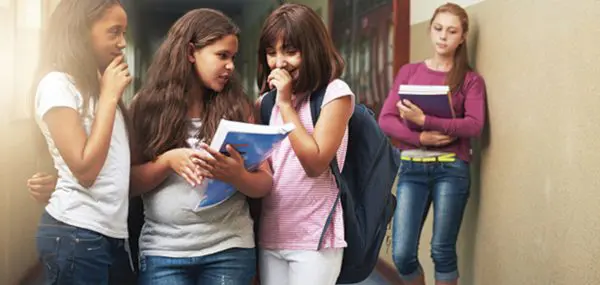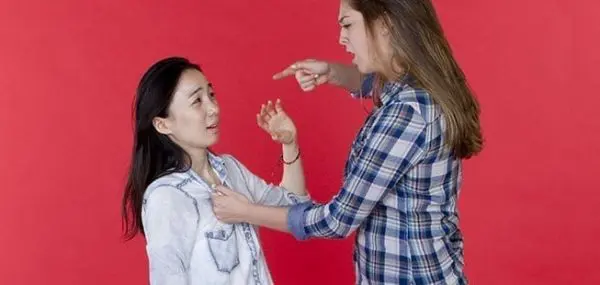Bullying Prevention: What Parents Can Do
A panel of experts shared helpful information on bullying and bullying prevention: Dr. David Hussey of Kent State College of Public Health, Paulie Velotta of the Olweus Bullying Prevention Program, and David Frattare of the Ohio Internet Crimes Against Children Task Force. Questions from the audience are answered below.
Paulie Velotta
Q: Is mediation a good intervention for bullying situations?
Velotta: Mediation, either with staff and students or peer-to-peer is not the best approach in a bullying situation. Bullying is a form of victimization —it is not a conflict.
In a conflict situation, mediation brings two parties together to solve a problem. It is voluntary and both students want to resolve the situation. In bullying, there is an imbalance of power and control. It may be very upsetting for the teen who has been bullied to face their tormentor — it is further victimization. Mediation also sends the message that both parties are partly right and partly wrong. The message that needs to be sent in a bullying situation is that no one deserves to be bullied, and it is unacceptable behavior.
When both students want to work out a misunderstanding (conflict) then mediation is an excellent means toward resolution. However, if it is true bullying (victimization), meet separately with the one who is being bullied and the one who is doing the bullying to develop a safety plan and an intervention plan.
Q: What if the school won’t intervene until the bullying gets more severe?
Velotta: Every teen has the right to feel safe in their school environment. In Ohio (House Bill 276), every school district must have a policy to investigate all bullying incidents brought to their attention. Use the following steps to work with school officials to address bullying:
- Ask for a copy of the school bullying policy.
- Keep written and detailed records of every incident reported by your child.
- Meet with every adult who can have a positive impact on the bullying, including the classroom teacher, the school guidance counselor or school-based mental health professional, the school principal, and the superintendent if the situation remains unresolved.
- In a positive way, suggest a collaborative approach that incorporates the parents, teens, and teachers to develop a safety plan.
- Set up a subsequent meeting to review the progress.
- Keep notes from every communication. If the bullying behavior persists, send a written correspondence to the school staff.
- If your teenager is threatened or physically assaulted, contact the police.
- If the bullying escalates or persists, you may need to consult an attorney.
Q: What signs should a school bus driver look for to identify bullying among students?
Velotta: A school bus driver has a difficult job of looking out for passengers while driving a two-ton piece of machinery. The driver is facing forward and the only visibility of the teens is in the mirror. The driver needs the help of reliable student leaders who can identify the bullying and report it. There are indicators such as students who refuse to let another student sit by them, hurtful words, and possessions being thrown. Students who are afraid may ask to sit up front near the driver. Some students have reported listening to their iPods to avoid bullying situations.
The bus is an extension of the classroom, so developing an opportunity to build community is a helpful intervention to reduce or prevent bullying. There is an excellent resource for school bus drivers called, The Peaceful School Bus. Copies are available from Hazelden Publishing at http://www.hazelden.org/web/go/peacefulschoolbus.
Q: Because bullying is often under the radar, what can the school do?
Velotta: Most bullying is under the radar. School personnel have a difficult job. The school must include all the parties in its investigation and develop a plan with the students. The school bully policy should be to intensify adult oversight. For example, if the reported bullying occurred in a particular hallway, make staff aware and station them in that area. Consistent observations and communication with staff is essential.
In a comprehensive program, you should be able to enlist responsible students to be observant and vigilant in reporting situations to you. Reassure the students that you will not use their names and that there will be no repercussions.
Q: What if the bullying is subtle and passive, like ignoring the victim?
Velotta: Schools that use a comprehensive bullying prevention program incorporate a classroom component called the Class Meeting where students build community and make positive connections with fellow students. The experience in the Class Meeting discourages bullying because everyone becomes acquainted and learns to work together. Exclusion or ignoring one another is not tolerated because everyone is learning to respect each other’s commonalities and differences, while learning the responsibility of the Golden Rule: to treat others as they want to be treated.
At home, parents should acknowledge the pain of being ignored and talk about true friendship. Discuss the need for respectful friends. Encourage teens to join clubs or organizations where they can be part of a group with a common interest.
Q: “He said, She said” – What’s the truth?
Velotta: This is complicated. Most times, the truth lies in the middle. I would encourage each person to write his or her version of the story. When the two stories diverge, have them rewrite. In many cases, this helps them get closer to the truth. The students should answer the following questions: In your own words, explain what happened in detail. How do you think the other person felt? What could you have done differently?
A school must have consequences for negative actions, and a safety plan for victimization is extremely important. Unfortunately, in “He said, She said” situations, both students often end up with a consequence, even when one is truly the victim.
Q: What can a teacher do without support from the administration or the parents?
Velotta: While you may not have the support you need from the outside, class meetings are an excellent way to build positive relationships, problem solve, and foster a working community. You may try one strategy: group agreements. Have the students list what they need in order to be able to work together as a community. Add what you need and have all the students sign the agreement poster. Set a weekly class meeting to get acquainted and talk about bullying situations, bullying prevention, or other student concerns. Some resources include, Class Meetings That Matter and Bully Free Classroom.
Dr. David Hussey
Q: Do you see an increase in bullying behavior?
Hussey: I don’t think so, at least not in traditional bullying. What’s changed is our awareness of it. Violent or dramatic cases of serious bullying are quickly and widely disseminated. Best estimates, national and international, are that approximately 20% of children report being bullied.
There is, however, significantly more cyberbullying. According to at least one study, between 2000 and 2005 there was a 50% increase in cyberbullying. This new technology has created other opportunities to bully. Also, victims who may never have endured traditional bullying are now vulnerable to electronic bullying.
Q: We taught our teens to turn the other cheek, we notified teachers and the principal; yet, the bullying continues. Now what?
Hussey: You need to keep prodding the school. If you get no response, don’t be afraid to go up the ladder. Put your concerns in writing and copy others.
Bullying is a relational problem that requires relational solutions. I strongly advise that parents work the bullying issue on multiple levels, including the individual child, other peers, school personnel, and possibly, other parents.
Q: How do we protect teens with disabilities who can’t protect themselves?
Hussey: When children can’t protect themselves, adults must develop protection and support systems. This can usually be done with other adults across school and community settings, but may be particularly effective if those adults (teachers) can help mobilize other peers, particularly those who are empathetic, supportive, assertive, and protective. Generally, they are more likely to be female. Ideally, these peers would have high social status within the group.
Q: What is the role of a school counselor when a bullied kid reports a desire to self-injure or to attempt suicide?
Hussey: A school counselor can play a critical role because concerned peers are more likely to inform a teacher or school counselor of potential self-injurious behavior than an outside therapist with whom they have no relationship. And the peer support network is often the earliest and most active safety monitoring system.
Q: What should a parent do when a teen refuses to report incidences of ruthless bullying for fear of greater repercussions?
Hussey: This is a delicate situation. I suggest that you first attempt to understand your teen’s concerns about reporting. At some point, the adult may need to take charge. The consequences of not reporting may outweigh the concerns regarding repercussions for reporting. There may be options regarding how and to whom you report. Also, certain types of reporting may provide protection for the teen. Your teen displayed trust in you by opening this dialogue; you need to continue the conversation and build upon this trust.
Q: Under which circumstances do you call another parent?
Hussey: In general, try to resolve the bullying on a peer level first. If that isn’t successful, carefully consider your options, including the merits of approaching the bullying teen’s parents. Don’t assume that the parent of a bully is necessarily also is a bully, or that a parent will be unresponsive. Naturally, you are in a better position to assess when you know the other parent. I’ve seen this work well many times, but in my experience, it is more likely to work in cases where the bullying is less severe, and the children are younger. If you choose to call a parent, prepare your approach. Ask yourself, if your teenager was the bully, how would you want to hear this from another parent? Practice what you will say, and don’t call or make contact when you are angry.
David Frattare
Q: How can I monitor my daughter’s iPAD Touch that has WIFI access?
Frattare: There are several apps under development by third-party vendors (i.e. iPad Mobile Spy and Apple iPad Spy Software). As with any monitoring software, you must consider the features and abilities of the software and consider what you are trying to monitor. Also, find software that will run covertly in the background of the operating system.
There are also several programs that can analyze Internet traffic on your network and capture bits of information from other users (your daughter in this case). Most common is a tool available for Windows and Unix operating systems known as Netstat. Netstat is a command line tool that displays network connections (incoming and outgoing) and network interface statistics. Netstat is a command that you can enter in the command prompt program that is found inside the Accessories folder within Windows. A Google search of this program should give you a basic idea of how to read and understand the data returned.
Q: Does Facebook work with schools on dealing with cyberbullying?
Frattare: Facebook has a varied track record when it comes to dealing with problems encountered on their site. Given their size and popularity, policing the site on a daily basis has become more difficult. Facebook does submit cybertips to the National Center for Missing and Exploited Children when it becomes aware of problems on the site, and those tips are then handled by the respective law enforcement agency where the problem is occurring. The best course of action is to notify the school or your police department directly if you’re dealing with cyberbullying that may potentially lead to physical or mental harm.
Q: Is spyware on computers relevant anymore now that teens are using cell phones?
Frattare: Desktop and laptop computers are still a huge part of our society, and I am a proponent of monitoring software because it can keep watch over your computer when you are not around. Programs like WebWatcher, EBlaster, Spector Pro and Net Nanny are some of the many programs available that will covertly monitor your computer and alert you to any problems. As with any of these programs, make sure you review them carefully to ensure they include features specific to your problem or area of concern. These programs should not become a replacement for daily parental supervision.
The best monitoring software for cell phones is a consistent review of the phone bill. Most carriers have Internet sites that will allow you to log into your account and see daily updates with regard to text messaging and phone calls. Mymobilewatchdog.com is a program that, for a monthly fee, will allow you to see all of the content received on your child’s phone sent directly to your computer or mobile device, including text messages, picture and video messages and email. (The mobilewatchdog.com software is new and has huge potential with regard to sexting and cyberbullying.) Don’t forget that as the purchaser and parent of a teenage cell phone user, you have the right and the duty to inspect the cell phone and its contents to ensure that your children are safe and not involved in what could be considered criminal activity.
I will offer one last piece of advice. The best tool for parents is to be on Facebook and Twitter and see what their kids are doing online and on their cell phones. You cannot be afraid of new technology. Take the plunge and become familiar with the technology that your children are using on a daily basis.
Disclaimer: The mention of specific programs and software are based on feedback from parents and software developer and should not be construed as endorsements from the ICAC.
Ohio ICAC, Bill Mason, Chairman, www.ohioicac.org







